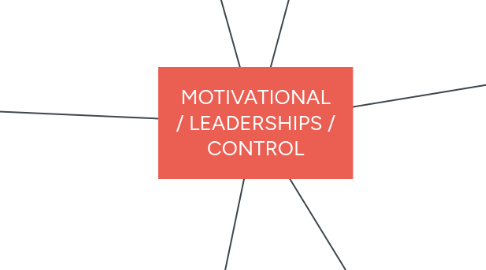
1. STRATEGIES
1.1. 1. Reinforcement / Behaviour Modification
1.1.1. Performance = Rewards
1.1.2. Punisment = Negative Reinfircement
1.2. 2. Management by Objective (MBO)
1.2.1. Peter Drucker (1954)
1.2.2. Collaborative Goal Setting between manager / subordinates
1.3. 3. Employee Empowerment
1.3.1. Employee can make decision
1.4. 4. Job Enrichment / Redesign
1.4.1. 1. JOB ENRICHMENT
1.4.1.1. Adding one or more job activities
1.4.1.2. Job Rotation
1.4.2. 2. JOB REDESIGN
1.4.2.1. Design more satisfactory fit betwwen workers and their jobs
1.5. 5. Modified Work Schedules
1.5.1. Work Share Programs
1.5.1.1. Job Sharing
1.5.2. Flextime Programs
1.5.2.1. Allows worker to adjust their schedules
1.5.3. Telecommunicating / Virtual Office
1.5.3.1. Keyword = Technology
2. LEADERSHIPS
2.1. Definition
2.1.1. Motivating others to work
2.2. Managerial Styles
2.2.1. 1. Autocratic
2.2.1.1. Rapid decision making
2.2.1.2. Issue Orders
2.2.2. 2. Democratic
2.2.2.1. Ask opinion from subordinates
2.2.3. 3. Free-rein
2.2.3.1. Subordinates can make decision
2.3. 21st Century Leaderships
2.3.1. 1. Motivation
2.3.1.1. Different desire at work
2.3.1.2. Money no longer prime
2.3.2. 2. Leaderships
2.3.2.1. Flatter Organization = Less Autocratic
2.3.2.2. Network mentality
3. CONTROLLING
3.1. Definition
3.1.1. Verifying whether everything occurs in conformities with the plans adopted, instructed issued and principles established
3.2. Importance
3.2.1. 1. Facilitates Co-ordination
3.2.2. 2. Helps in Planning
3.2.3. 3. Protecting the Workplace
3.3. Process
3.3.1. 1. Establish performance objctives & standards
3.3.2. 2. Measure actual performance
3.3.3. 3. Compare no 1 and 2
3.3.4. 4. Take neccessary action
3.4. Types
3.4.1. Manager ability to lead and motivate people
3.4.2. Feedforward Controls
3.4.2.1. Work inputs
3.4.2.2. Ensure the right directions are set
3.4.2.3. Solve problem before the occur
3.4.3. Concurrent Controls
3.4.3.1. Work throughputs
3.4.3.2. Ensure the right things are being done
3.4.3.3. Solve problems while the occur
3.4.4. Feedback Controls
3.4.4.1. Work outputs
3.4.4.2. Ensure that final results are up to desired standards
3.4.4.3. Solve the problems after the occur
4. MANAGEMENT / LEADERSHIPS
4.1. Organisation and team can count on :
4.1.1. 1. Provide leaderships
4.1.2. 2. Make wise decision
4.1.3. 3. Focus effort productively
5. PSYCHOLOGIST CONTRACTS
5.1. 1. Importance of Satisfaction
5.1.1. a. Job Satisfaction
5.1.2. b. Morale = Overall attitude (High better)
5.1.3. c. Turnover (Low better)
5.2. 2. High Priorities
5.2.1. a. Family orientation
5.2.2. b. Sense of community
5.2.3. c. Quality of life issues
6. THEORIES
6.1. Motivation in Workplace
6.1.1. 1. Classical
6.1.1.1. a. Frederick Taylor (1911)
6.1.1.2. b. Pemikiran lama
6.1.2. 2. Behavior
6.1.2.1. a. Hawthorne Studies
6.1.2.2. b. Physical environment changes affect workers output
6.1.3. 3. Contemporary motivational theories
6.1.3.1. a. Human Resources Model
6.1.3.1.1. Theory X
6.1.3.1.2. Theory Y
6.1.3.1.3. Douglas McGregor
6.1.3.2. b. Maslow's Hierarchy
6.1.3.2.1. Abraham Maslow's
6.1.3.3. c. Two Factory Theory
6.1.3.3.1. Frederick Hezbergs
6.1.3.3.2. Motivation
6.1.3.3.3. Hygiene
6.1.3.4. d. Expectancy Theory
6.1.3.4.1. Victor Vroom
6.1.3.4.2. People = Rewards

